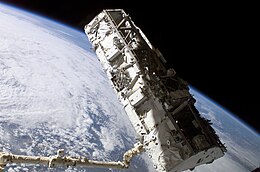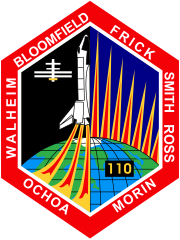
Back STS-110 Arabic STS-110 Bulgarian STS-110 Catalan STS-110 Czech STS-110 Danish STS-110 German STS-110 Greek STS-110 Spanish STS-110 Estonian استیاس-۱۱۰ Persian
 Canadarm2 grapples the first segment of the ISS' Integrated Truss Structure | |
| Names | Space Transportation System-110 |
|---|---|
| Mission type | ISS assembly |
| Operator | NASA |
| COSPAR ID | 2002-018A |
| SATCAT no. | 27413 |
| Mission duration | 10 days, 19 hours, 43 minutes, 38 seconds |
| Distance travelled | 7,240,000 kilometers (4,500,000 mi) |
| Orbits completed | 171 |
| Spacecraft properties | |
| Spacecraft | Space Shuttle Atlantis |
| Launch mass | 116,609 kilograms (257,079 lb)[1] |
| Landing mass | 91,016 kilograms (200,657 lb)[1] |
| Payload mass | 13,132 kilograms (28,951 lb) |
| Crew | |
| Crew size | 7 |
| Members | |
| Start of mission | |
| Launch date | 8 April 2002 20:44:19 UTC |
| Launch site | Kennedy LC-39B |
| End of mission | |
| Landing date | 19 April 2002 16:26:57 UTC |
| Landing site | Kennedy SLF Runway 33 |
| Orbital parameters | |
| Reference system | Geocentric |
| Regime | Low Earth |
| Perigee altitude | 155 kilometres (96 mi) |
| Apogee altitude | 225 kilometres (140 mi) |
| Inclination | 51.6 degrees |
| Period | 88.3 minutes |
| Docking with ISS | |
| Docking port | PMA-2 (Destiny forward) |
| Docking date | 10 April 2002 16:05 UTC |
| Undocking date | 17 April 2002 18:31 UTC |
| Time docked | 7 days, 2 hours, 26 minutes |

 In front, (L-R): Stephen N. Frick, Ellen L. Ochoa, Michael J. Bloomfield; In the back, (L-R): Steven L. Smith, Rex J. Walheim, Jerry L. Ross and Lee M. E. Morin. | |
STS-110 was a Space Shuttle mission to the International Space Station (ISS) on 8–19 April 2002 flown by Space Shuttle Atlantis. The main purpose was to install the S0 Truss segment, which forms the backbone of the truss structure on the station.